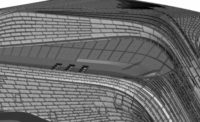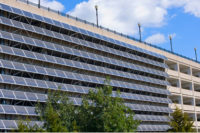Creating More Sustainable Structures with Modular Textile Facades

FBI Regional Headquarters parking facility Photo by Darren Bradley. Courtesy of Serge Ferrari Group
As the cost of traditional building materials continues to rise and access to resources grows more difficult, architects, building owners, and developers are continuously seeking new solutions that are innovative, sustainable, and visually engaging for both new builds and renovations. Choosing eco-conscious materials where sustainability is a top priority not only benefits the environment but also yields significant cost benefits for owners and developers in the long term.
For builders looking for a modern, durable solution outside of traditional building components, textile modular construction materials have grown in popularity due to their adaptable nature and versatility for potential uses. For instance, these materials play a pivotal role in increasing the energy efficiency of a building by minimizing the use of heat and air conditioning as a result of exceptional thermal regulation capabilities. Durability is also essential to prevent frequent replacements or repairs; this is particularly important for large stadiums, airports, landmarks, or buildings located in regions where extreme weather patterns are common.
Regulating Heat and Light
One immediate benefit of textile modular construction in comparison to traditional building materials is its flexibility. Their ability to be applied to any building facade, in any shape or form, allows the structure to be optimally outfitted to match the thermal regulation requirements and the building design. Installing the proper material on fixed or moveable tracks creates a facade that can be adjusted throughout the day to continually block out excess light and heat as needed. Modular textile construction is more reliable and effective than interior blinds and can be designed to the exact aesthetic specifications of the owner or developer of the property.
For office building owners, this is essential — to provide a work environment that minimizes the glare employees experience while also giving them adequate access to sunlight during the day. Black-out interior curtains are typically chosen to achieve the same effect but can create bleak and uninviting workspaces. The exterior installation of high-performance textile modular construction materials also offers the perfect balance of sufficient sunlight to energize workers and encourage them to be productive throughout the day without harming their eyes or causing a damaging glare from the screens they look at while working.
Thermal and light regulation is also a priority for outdoor arenas, especially in warmer climates where events occur through the heat, humidity, and sun. To protect players and spectators, textile modular construction materials can take shape as a textile roof that is durable, structural, and lightweight. With the correct balance of the light needed to illuminate sporting events and concerts that will protect players or attendees, these structures offer the best possible protection from the sun, wind, and cold during the winter season.
The breathability of the membranes also offers optimal ventilation with air being able to pass through to regulate the temperature of outdoor arenas in an energy-efficient manner. As hubs for the city where residents gather to enjoy sporting events and concerts, these stadiums are also viewed as landmarks that reflect the history and people of the region. The infinite range of design capabilities that modular construction provides allows operators and owners to dress these venues in colors, patterns, and shapes that evoke and tie into local themes. These customized and unique options offer more ways to adhere to brand standards and be creative than a traditional roof or awning.
Increased Energy Savings
As a result of exceptional heat and light regulation, buildings and structures that implement textile facades experience higher energy savings than those built with traditional construction materials. A 2018 Buildings study concluded that in comparison to only one glass façade and an opaque roof, an additional translucent and thermally insulated membrane roof increased the continuous Daylight Autonomy from 15% to 38%. This resulted in a 30% reduction in the electricity needed for artificial lighting in the roof-covered area of the sports field used in this study. These results created a benchmark for planners, investors, and future buildings of this type as they showed the direct impact these materials have on the energy usage of these textile structures.
While this study is immensely useful for similar arenas and stadiums, the key takeaway can also be applied to multifamily and commercial buildings where energy efficiency and the goal of minimal heating and air conditioning use are a priority. Rather than constantly needing to adjust the thermostat, which in itself drives up energy consumption, controlling the amount of light and heat that enters a building from the exterior automatically stabilizes the indoor temperature. Removing this variable allows building owners to set their heating or cooling systems at one constant degree throughout the season, ensuring a fixed temperature and predictable energy bill at the end of each month. This is especially important for companies or building owners who want to further minimize their environmental footprint and not use excess energy throughout the seasons. Instead, they can rely on the moderate temperature created as a result of these textile facades.
Optimal Durability
High-performance modular construction materials are developed with technology that ensures long-term durability against wind, rain, sand, and sun, resulting in a facade that can be installed anywhere from the desert to the rainforest. Dubai’s iconic hotel, the Burj al Arab, was built in 1999 and includes this very high-performance material to preserve the landmark’s exterior. The color has been maintained for almost 20 years and there has been no tearing from sandstorms that are characteristic of the region. The hotel is also located on the shores of the Persian Gulf, offering stunning views of the Dubai marina yet it has resisted any wear from the saltwater. The membrane used to cover 200 meters of the building’s exterior successfully protected it against harsh UV rays, saltwater, and sand, and continues to do so today.
Modular construction textile materials are increasingly sought after as they are an innovative and sustainable alternative to traditional building materials with their flexible, durable, and sustainable characteristics. Not only can they be used for a variety of applications, but these materials also provide significant benefits in terms of energy efficiency, providing exceptional thermal regulation and light control that contribute to reducing energy consumption and lower operational costs. These materials’ long-term durability ensures that venues can withstand extreme weather conditions, offering protection and longevity for iconic structures worldwide. As demand for energy-efficient and sustainable facade solutions continues to grow, modular construction materials will play an increasingly important role in shaping the future of modern architecture and building design.
Looking for a reprint of this article?
From high-res PDFs to custom plaques, order your copy today!







